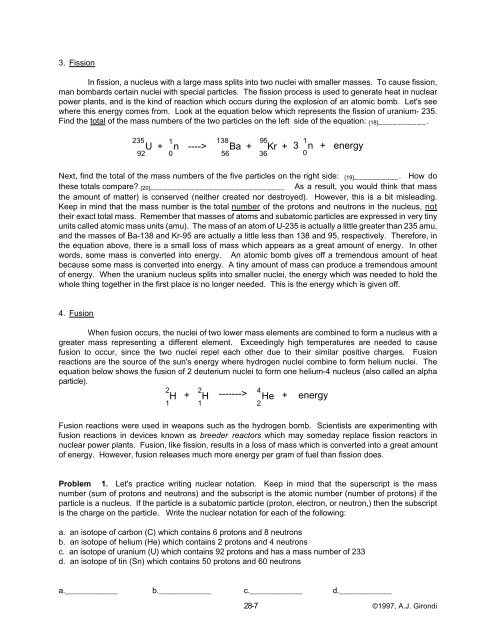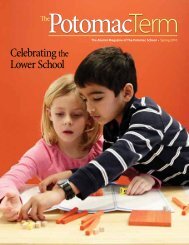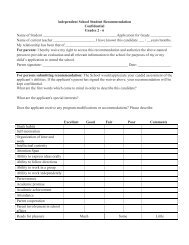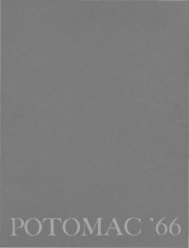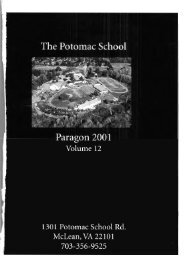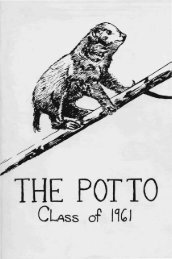Active Learning In Chemistry Education - Potomac School
Active Learning In Chemistry Education - Potomac School
Active Learning In Chemistry Education - Potomac School
Create successful ePaper yourself
Turn your PDF publications into a flip-book with our unique Google optimized e-Paper software.
3. Fission<br />
<strong>In</strong> fission, a nucleus with a large mass splits into two nuclei with smaller masses. To cause fission,<br />
man bombards certain nuclei with special particles. The fission process is used to generate heat in nuclear<br />
power plants, and is the kind of reaction which occurs during the explosion of an atomic bomb. Let's see<br />
where this energy comes from. Look at the equation below which represents the fission of uranium- 235.<br />
Find the total of the mass numbers of the two particles on the left side of the equation: {18} __________.<br />
235<br />
U +<br />
92<br />
1<br />
n<br />
0<br />
138<br />
----> Ba +<br />
56<br />
95<br />
Kr +<br />
36<br />
1<br />
3 n + energy<br />
0<br />
Next, find the total of the mass numbers of the five particles on the right side: {19} __________. How do<br />
these totals compare? {20} ______________________________ As a result, you would think that mass<br />
the amount of matter) is conserved (neither created nor destroyed). However, this is a bit misleading.<br />
Keep in mind that the mass number is the total number of the protons and neutrons in the nucleus, not<br />
their exact total mass. Remember that masses of atoms and subatomic particles are expressed in very tiny<br />
units called atomic mass units (amu). The mass of an atom of U-235 is actually a little greater than 235 amu,<br />
and the masses of Ba-138 and Kr-95 are actually a little less than 138 and 95, respectively. Therefore, in<br />
the equation above, there is a small loss of mass which appears as a great amount of energy. <strong>In</strong> other<br />
words, some mass is converted into energy. An atomic bomb gives off a tremendous amount of heat<br />
because some mass is converted into energy. A tiny amount of mass can produce a tremendous amount<br />
of energy. When the uranium nucleus splits into smaller nuclei, the energy which was needed to hold the<br />
whole thing together in the first place is no longer needed. This is the energy which is given off.<br />
4. Fusion<br />
When fusion occurs, the nuclei of two lower mass elements are combined to form a nucleus with a<br />
greater mass representing a different element. Exceedingly high temperatures are needed to cause<br />
fusion to occur, since the two nuclei repel each other due to their similar positive charges. Fusion<br />
reactions are the source of the sun's energy where hydrogen nuclei combine to form helium nuclei. The<br />
equation below shows the fusion of 2 deuterium nuclei to form one helium-4 nucleus (also called an alpha<br />
particle).<br />
2 2<br />
4<br />
H + H -------> He + energy<br />
1 1<br />
2<br />
Fusion reactions were used in weapons such as the hydrogen bomb. Scientists are experimenting with<br />
fusion reactions in devices known as breeder reactors which may someday replace fission reactors in<br />
nuclear power plants. Fusion, like fission, results in a loss of mass which is converted into a great amount<br />
of energy. However, fusion releases much more energy per gram of fuel than fission does.<br />
Problem 1. Let's practice writing nuclear notation. Keep in mind that the superscript is the mass<br />
number (sum of protons and neutrons) and the subscript is the atomic number (number of protons) if the<br />
particle is a nucleus. If the particle is a subatomic particle (proton, electron, or neutron,) then the subscript<br />
is the charge on the particle. Write the nuclear notation for each of the following:<br />
a. an isotope of carbon (C) which contains 6 protons and 8 neutrons<br />
b. an isotope of helium (He) which contains 2 protons and 4 neutrons<br />
c. an isotope of uranium (U) which contains 92 protons and has a mass number of 233<br />
d. an isotope of tin (Sn) which contains 50 protons and 60 neutrons<br />
a.____________ b.____________ c.____________ d.____________<br />
28-7 ©1997, A.J. Girondi


